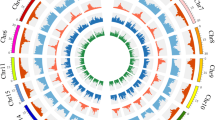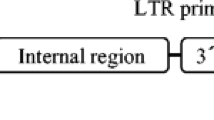Abstract
Retrotransposons are the largest group of transposable elements (TEs) that are ubiquitous and well dispersed in plant genomes. Transposition/insertion of TEs on chromosomes often generates unique repeat junctions (RJs) between TEs and their flanking sequences. Long terminal repeats (LTR) are well conserved and abundant in plant genomes, making LTR retrotransposons valuable for development of TE junction-based markers. In this study, LTR retrotransposons and their RJs were detected from chokecherry genome sequences generated by Roche 454 sequencing. A total of 1246 LTR retrotransposons were identified, and 338 polymerase chain reaction primer pairs were designed. Of those, 336 were used to amplify DNA from chokecherry and other rosaceous species. An average of 283 of 336 (84.2 %) LTR primer pairs effectively amplified DNA from chokecherries. One hundred and seventeen chokecherry LTR primers also produced amplification in other Prunus (99) or rosaceous species (19). A total of 59 of 78 polymorphic LTR markers were qualified for linkage map construction according to the segregation distortion Chi-square (χ 2) test. Forty-eight LTR markers were successfully located on a previously constructed chokecherry map. The majority of the LTR markers were mapped on LG XI of the chokecherry map. Our results suggest that LTR marker development using random genome sequences is rapid and cost-efficient. Confirmed applicability of LTR markers in map construction and genetic mapping will facilitate genetic research in chokecherry and other rosaceous species.


Similar content being viewed by others
References
Baránek M, Meszáros M, Sochorová J, Čechová J, Raddová J (2012) Utility of retrotransposon-derived marker systems for differentiation of presumed clones of the apricot cultivar Velkopavlovická. Sci Hort 143:1–6
Bennetzen JL (2000) Transposable element contributions to plant gene and genome evolution. Plant Mol Biol 42:251–269
Bennetzen J (2005) Transposable elements, gene creation and genome rearrangement in flowering plants. Curr Opin Genet Dev 15:621–627
Castillo A, Budak H, Martin AC, Dorado G, Borner A, Roder M, Hernandez P (2010) Interspecies and intergenus transferability of barley and wheat D-genome microsatellite markers. Ann Appl Biol 156:347–356
Cavagnaro PF, Senalik DA, Yang L, Simon PW, Harkins TT, Kodria CD, Huang S, Weng Y (2010) Genome-wide characterization of simple sequence repeats in cucumber (Cucumis sativus L.). BMC Genom 11:569–586
Collard BCY, Jahufer MZZ, Brouwer JB, Pang ECK (2005) An introduction to markers, quantitative trait loci (QTL) mapping and marker-assisted selection for crop improvement: the basic concepts. Euphytica 142:169–196
Constable FE, Gibb KS (2006) Eastern peach X disease (Western X-disease phytoplasma) Updated on 10/21/2011 9:32:02 AM: PaDIL http://www.padil.gov.au
Du XY, Hu QN, Zhang QL, Luo Wang YB (2013) Transferability of retrotransposon primers derived from persimmon (Diospyros kaki Thunb.) across other plant species. Genet Mol Res 12:1781–1795
Flavell AJ, Knox MR, Pearce SR, Ellis THN (1998) Retrotransposon-based insertion polymorphisms (RBIP) for high throughput marker analysis. Plant J 16:643–650
Grandbastien MA (1992) Retroelements in higher plants. Trends Genet 8:103–108
Hackett CA, Luo ZW (2003) TetraploidMap: construction of a linkage map in autotetraploid species. J Hered 94:358–359
Hackett CA, Milne I, Bradshaw JE, Luo Z (2007) TetraploidMap for Windows: linkage map construction and QTL mapping in autotetraploid species. J Hered 98:727–729
Halász J, Kodad O, Hegedus A (2014) Identification of a recently active Prunus-specific non-autonomous Mutator element with considerable genome shaping force. Plant J 79:220–231
Jun TH, Michel AP, Mian MAR (2011) Development of soybean aphid genomic SSR markers using next generation sequencing. Genome 54:360–367
Kalendar R (2011) The use of retrotransposon-based molecular markers to analyze genetic diversity. Ratar Povert/Field Veg Crop Res 48:261–274
Kalendar R, Flavell AJ, Ellis TEN, Sjakste T, Moisy C, Schulman AH (2011) Analysis of plant diversity with retrotransposon-based molecular markers. Heredity 106:520–530
Kumar A, Bennetzen J (1999) Plant retrotransposons. Annu Rev Genet 33:479–532
Liu J, Qu J, Yang C, Tang D, Liu J, Lan H, Rong T (2015) Development of genome-wide insertion and deletion markers for maize, based on next-generation sequencing data. BMC Genom 16:601
Lodhi MA, Ye GN, Weeden NF, Reisch BI (1994) A simple and efficient method for DNA extraction from grapevine cultivars, Vitis species and Ampelopsis. Plant Mol Biol Rep 12:6–13
Lou Q, Chen J (2007) Ty1-copia retrotransposon-based SSAP marker development and its potential in the genetic study of cucurbits. Genome 50:802–810
Mardis ER (2008) The impact of next-generation sequencing technology on genetics. Trends Genet 24:133–141
Mnejja M, Garcia-Mas J, Audergon JM, Arús P (2010) Prunus microsatellite marker transferability across rosaceous crops. Tree Genet Genomes 6:689–700
Park YH, Ahn SG, Choi YM, Oh HJ, Ahn DC, Kim JG, Kang JS, Choi YW, Jeong BR (2010) Rose (Rosa hybrid L.) EST-derived microsatellite markers and their transferability to strawberry (Fragaria spp.). Sci Hort 125:733–739
Pearce SR, Harrison G, Li D, Heslop-Harrison JS, Kumar A, Flavell AJ (1996) The Ty1-copia group retrotransposons in Vicia species: copy number, sequence heterogeneity and chromosomal localization. Mol Gen Genet 250:305–315
Rehder A (1940) Manual of cultivated trees and shrubs, 2nd edn. McMillan, New York, pp 452–481
SanMiguel P, Tikhonov A, Jin YK et al (1996) Nested retrotransposons in the intergenic regions of the maize genome. Science 274:765–768
Schulman AH, Kalendar R (2005) A movable feast: diverse retrotransposons and their contribution to barley genome dynamics. Cytogenet Genome Res 110:598–605
Schulman AH, Flavell AJ, Paux E, Ellis THN (2012) The applications of LTR retrotransposons as molecular markers in plants. Methods Mol Biol 859:115–153
Senkova S, Žiarovská J, Bežo M, Štefúnová V, Ražná K (2013) Utilization of IRAP technique for plums genotypes differentiation. Biosci Res 10:1–07
Shen Y, Ding X, Fei W, Cai B, Gao Z, Zhang Z (2011) Analysis of genetic diversity in Japanese apricot (Prunus mume Sieb. et Zucc.) based on REMAP and IRAP molecular markers. Sci Hort 132:50–58
Vezzulli S, Micheletti D, Riaz S, Pindo M, Voila R, This P, Walker MA, Troggio M, Velasco R (2008) A SNP transferability survey with the genus Vitis. BMC Plant Biol 8:128. doi:10.1186/1471-2229-8-128
Voorrips RE (2002) MapChart: software for the graphical presentation of linkage maps and QTLs. J Hered 93(1):77–78
Wang H, Walla JA, Zhong S, Huang D, Dai W (2012) Development and cross-species/genera transferability of microsatellite markers discovered using 454 genome sequencing in chokecherry (Prunus virginiana L.). Plant Cell Rep 31:2047–2055
Wang H, Walla JA, Magnusson VA, Zhong S, Dai W (2014) Construction of a linkage map and QTL mapping for X-disease resistance in tetraploid chokecherry (Prunus virginiana L.) using SSR and AFLP markers. Mol Breed 34:143–157
Wanjugi H, Coleman-Derr D, Huo N, Kianian SF, Luo MC, Wu J, Anderson O, Gu YQ (2009) Rapid development of PCR-based genome-specific repetitive DNA junction markers in wheat. Genome 52:576–587
Wicker T, Sabot F, Hua-Van A et al (2007) A unified classification system for eukaryotic transposable elements. Nat Rev Genet 8:973–982
Wünsch A (2009) Cross-transferable polymorphic SSR loci in Prunus species. Sci Hortic 120:348–352
You FM, Wanjugi H, Huo N, Lazo GR, Luo MC, Anderson OD, Dvorak J, Gu YQ (2010) RJPrimers: unique transposable element insertion junction discovery and PCR primer design for marker development. Nucl Acid Res 38:313–320
Yu F, Wang BH, Feng SP, Wang JY, Li WG, Wu YT (2011) Development, characterization, and cross-species/genera transferability of SSR markers for rubber tree (Hevea brasiliensis). Plant Cell Rep 30:335–344
Zalapa JE, Cuevas H, Zhu H, Steffan S, Senalik D, Zeldin E, McCown B, Harbut R, Simon P (2012) Using next-generation sequencing approaches to isolate simple sequence repeat (SSR) loci in the plant science. Am J Bot 99:193–208
Zhu H, Senalik D, McCown BH, Zeldin EL, Speers J, Hyman J, Bassil N, Hummer K, Simon PW, Zalapa JE (2012) Mining and validation of pyrosequenced simple sequence repeats (SSRs) from American cranberry (Vaccinium macrocarpon Ait.). Theor Appl Genet 124:87–96
Acknowledgements
We thank Drs. D. Huang and H. Wang for valuable suggestions and comments when we were conducting the research. This research was supported in part by McIntire-Stennis Project ND06212, USDA-CSREES-2005-35300-15457, and the Talent Foundation of Jilin Academy of Agricultural Sciences and Department of Foreign Experts Affairs Project (SH132200038), Jilin Province, P. R. China.
Author’s contribution
YL and WD conceived and designed the study. YL and RL conducted the experiments and contributed equally to the work. WD supervised the research and guided data interpretation. YL, RL, and WD wrote the paper. All authors read and approved the final manuscript.
Author information
Authors and Affiliations
Corresponding author
Ethics declarations
Conflict of interest
The authors declare that they have no conflict of interest.
Electronic supplementary material
Below is the link to the electronic supplementary material.
Rights and permissions
About this article
Cite this article
Liang, Y., Lenz, R.R. & Dai, W. Development of retrotransposon-based molecular markers and their application in genetic mapping in chokecherry (Prunus virginiana L.). Mol Breeding 36, 109 (2016). https://doi.org/10.1007/s11032-016-0535-2
Received:
Accepted:
Published:
DOI: https://doi.org/10.1007/s11032-016-0535-2




